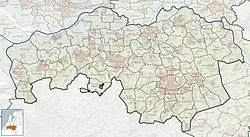Hooge Mierde
Hooge Mierde | |
|---|---|
Village | |
 Clergy house | |
| Coordinates: 51°23′15″N 5°07′47″E / 51.38750°N 5.12972°E | |
| Country | |
| Province | |
| Municipality | Reusel-De Mierden |
| Area | |
| • Total | 21.11 km2 (8.15 sq mi) |
| Elevation | 33 m (108 ft) |
| Population (2021)[1] | |
| • Total | 1,810 |
| • Density | 86/km2 (220/sq mi) |
| Time zone | UTC+1 (CET) |
| • Summer (DST) | UTC+2 (CEST) |
| Postal code | 5095[1] |
| Dialing code | 013 |
Hooge Mierde is a village in the municipality of Reusel-De Mierden in the province of North Brabant, the Netherlands. It was formerly part of Hooge en Lage Mierde municipality, and since 1997 it has become part of Reusel-De Mierden.
The village was first mentioned around 1200 as Myrtha, and means "settlement near the swamp". Hooge (high) has been added to distinguish from Lage Mierde.[3] Hooge Mierden is an agricultural village which developed in the Middle Ages on the Campine sand grounds. The Catholic St.-Jan Evangelist Church was built between 1922 and 1923 in expressionist style. The tower from the 15th century remained.[4]
Hooge Mierde was home to 121 people in 1840. It was part of the municipality of Hooge en Lage Mierde until 1997, when it was merged into Reusel-De Mierden.[5]
References[edit]
- ^ a b c "Kerncijfers wijken en buurten 2021". Central Bureau of Statistics. Retrieved 18 April 2022.
- ^ "Postcodetool for 5095AA". Actueel Hoogtebestand Nederland (in Dutch). Het Waterschapshuis. Retrieved 18 April 2022.
- ^ "Hooge Mierde - (geografische naam)". Etymologiebank (in Dutch). Retrieved 18 April 2022.
- ^ Chris Kolman & Ronald Stenvert (1997). Hooge Mierde (in Dutch). Zwolle: Waanders. ISBN 90 400 9945 6. Retrieved 18 April 2022.
- ^ "Hooge Mierde". Plaatsengids (in Dutch). Retrieved 18 April 2022.


